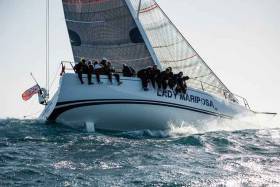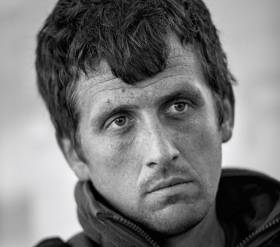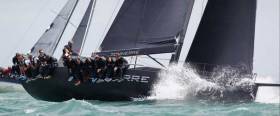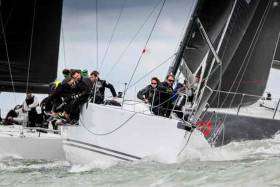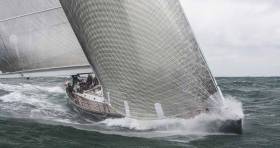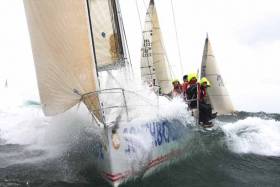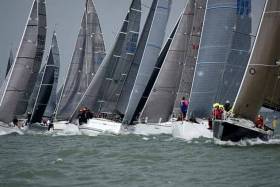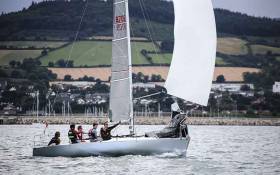Displaying items by tag: RORC
RORC De Guingand Bowl Race Preview
The Royal Ocean Racing Club's offshore racing season continues this weekend with the 4th race of the RORC Season's Points Championship. Over 80 yachts are expected to take part with the vast majority of the crews made up of passionate Corinthian sailors with their own set of goals.
Designed to last 24-36 hours, the De Guingand Bowl Race starts and finishes in the Solent and is a flexi-course allowing the Royal Ocean Racing Club to design a bespoke course.
"Without the constraint of finishing the race in a totally different location, we concentrate on the weather and tidal conditions to decide the course," explains RORC Racing Manager, Nick Elliott. "We try to get all of the fleet to finish the first beat in the same tidal vector, so as to avoid a tidal gate early in the race.”
In IRC Zero, Daniel Hardy's Ker 46 Lady Mariposa is the fastest yacht rated under the IRC rating system. However, several yachts in IRC One could challenge Lady Mariposa for Line Honours including Alan Hannon's RP45 Katsu, Edward Broadway's Ker 40 Hooligan VII, and Tor McLaren's MAT 1180 Gallivanter.
In IRC Two, Richard Neocleous' Ocean 55 Julia returns after its debut in last season's championship. The crew come from Hertfordshire and 18 year old Louie Neocleous will skipper Julia as he did last year.
“2016 was a great opportunity to put the team together and we all learnt a huge amount throughout the season.” commented Louie. “This year we are back to race much more competitively, we have a permanent race crew of 8. The remaining 6 crew are all friends, the boat's mate, Simon Jackson and I have crossed the Atlantic together and built a great relationship for the races. Last year, we were just beginners in terms of racing, our best result was 25th out of 86 boats in the Cervantes Trophy. This year, we hope to achieve better results on a consistent basis.”
In IRC Three, Trevor Sainty and Simon Forbes Jelenko is one of many J/109s that will be racing with the RORC this season. The crew have been together for about ten years and did their first Rolex Fastnet with Jelenko in 2015. The De Guingand Bowl Race is part of the teams programme for another crack at the Rolex Fastnet.
“All amateurs and we are all friends, most of the time.” smiled Trevor. “I am a veterinary surgeon working with horses, Simon works in the City, and the rest of the group are from the South of England and London, working in banking and IT. Our aim is to be top J/109 this season and improve our Fastnet finishing position by winning it of course. This will be my eighth consecutive Fastnet and last! - I said that last time.”
In IRC Four Dave Cooper & Paul England will be racing their Dehler 38 Longue Pierre. This will be their first RORC race this season, as part of their 2017 RORC Season’s Points Championship campaign.
“2017 is the 10th anniversary of us having won the great bowl overall.” commented Dave Cooper. This race will continue our rivalry with the Swan Xara. In 2016, we finished on equal points in JOG and the rivalry continues in both JOG and RORC this year. Longue Pierre is approaching her 30th birthday and has spent all of the last 30 years RORC racing.”
The 2017 De Guingand Bowl Race will start from the Royal Yacht Squadron Line, Cowes on Saturday 13th May
The world of sailing has so many sectors of interest that it’s challenging keeping track of the general picture. But even when you’ve achieved that basic level of comprehension, you then discover that each sector has so many sub-sectors that it all slips back into confusion. Once upon a time, W M Nixon though he’d a handle on the world of offshore racing. Now, he’s not so sure.
It’s all Tom Dolan’s fault. Most of you will know Tom as the farmboy from Meath who is cutting a remarkable swathe through the world of French Minitransat racing. Last week his name was back up in lights yet again after taking third in a fleet of 52 Minitransat boats in the 300-mile Pornichet Selector, which had these mighty atoms pinging up and down along France’s Biscay coast, with our man being overall leader at two stages.
He’s our Meath man now rather than a Meath farmboy, as he turned 30 on April 27th just after the race had finished. But he still has total boyish enthusiasm for the whole business, allied to a dogged yet adult dedication which is at such a level that it puts him on a different planet from most of the rest of us.
The plan for today was a quick look at Tom and what he’s doing as part of a general overview of the gradual regeneration of offshore racing and its various new areas of rapid development. But the problem is that, once you’ve sensed Tom’s enthusiasm and grasped just how utterly off the wall is his way of life, it takes over the whole show. So we’ll allow it to do so after a quick overview of the general scene.
And where better than to start with a quote from another man from Meath? We’ll always cherish the headline from The Meath Chronicle, when news of a certain sailing event in 1996 percolated through to the editorial headquarters of that esteemed journal in Navan:
LOBINSTOWN MAN WINS ROUND IRELAND YACHT RACE. That’s what it said. Real fame at last. Those of us who have a vague idea of Lobinstown’s location up near Nobber would have guessed it to be in Louth or even Monaghan. But not so, it’s clear over the border, into the Royal County and Meath Chronicle territory, and the Lobinstown man was Michael Boyd, who’d just knocked off the overall win in the big one with his J/35 Big Ears.
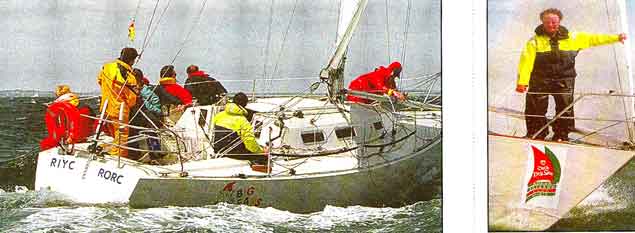 It’s 1996, and Michael Boyd’s J/35 Big Ears has just won Wicklow’s Round Ireland Race while her skipper (right) has become one of the earliest Afloat “Sailors of the Month”
It’s 1996, and Michael Boyd’s J/35 Big Ears has just won Wicklow’s Round Ireland Race while her skipper (right) has become one of the earliest Afloat “Sailors of the Month”
For that, he was our “Sailor of the Month” in the inaugural year of the contest, when we began to learn that monthly achievements, clearly highlighted at the time, amount to a very useful quick-reference history of Irish sailing years later. For the record, back in 1996 Big Ears was skippered by Michael Boyd with Jamie Boag (then 25) on navigation, tactics and alternate watch leader, Patsy Burke was relief helm and bowman, Brian Mehigan was bowman, ship’s doctor and cook, trimming team were P J Kennedy, David McHugh, Tim Greenwood and Michael Moloney, and Niall Dowling of the RIYC prepared the boat for the race.
Michael Boyd’s “Sailor of the Month” write-up also told us he’d done the Sydney-Hobart in 1993, the Newport-Bermuda in 1994, and the Fastnet in 1995, so with the Round Ireland won in 1996, you’d think that might be mission accomplished. But things were only getting going, and twenty years later he was back again – after much offshore racing since including being a winning co-skipper in the Irish Commodore’s Cup Team of 2014 – to race as Commodore Royal Ocean Racing Club in the 2016 Volvo Round Ireland Race, skippering the First 44.7 Lisa in which he was to finish third overall, and best Irish boat.
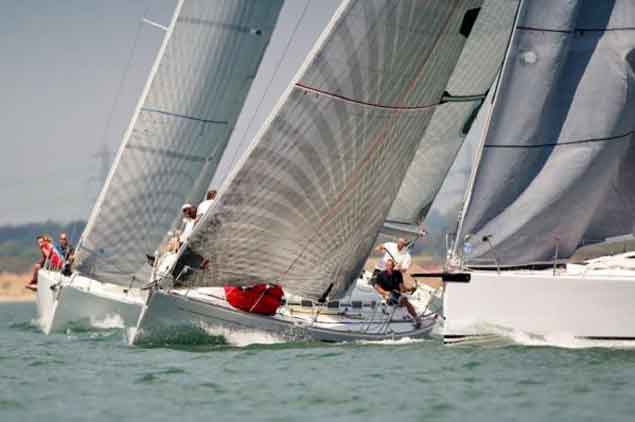 The First 44.7 Lisa at the start of the Volvo Round Ireland Race 2016
The First 44.7 Lisa at the start of the Volvo Round Ireland Race 2016
 Race organiser Theo Phelan around midnight in Wicklow with Michael Boyd when the latter had just finished the Volvo Round Ireland Race 2016 to place third overall.
Race organiser Theo Phelan around midnight in Wicklow with Michael Boyd when the latter had just finished the Volvo Round Ireland Race 2016 to place third overall.
Since then he has linked up with the JPK 10.80 Audrey for racing in Ireland, but he continues to make the scene with the core RORC programme in the English Channel with the First 44.7 Lisa, and last weekend he was one of a goodly fleet in the seasonal opener, the Cervantes Trophy from Cowes to Le Havre, with a very strong French contingent taking part.
0ne of them, the J/133 Pintia skippered by top French sailor Bruno Trouble, won overall from a fleet which reflected the fact that IRC continues to give very good racing for boats of all sizes, types and – in some cases – quite significant ages, as the J/133 dates from 2006, second by just 6 minutes was the Swan 44 Pomeroy Swan (Paul Kavanagh), third was Noel Racine’s regularly campaigned JPK 10.10 Foggy Dew, and fourth was the veteran Swan 55 yawl Lulotte (Ben Morris).
As for Lisa with Michael Boyd, she’d a good race, coming second to Pintia in Class 2, and ninth overall in a fleet of 84 starters. That looked like a pretty good turnout for the time of year, so Afloat.ie tracked down the Commodore of the RORC during the week to see did he share our feeling that there really is a new buzz to the offshore scene, and he responded with enthusiasm:
“Our sport seems to be in rude health these days, with much positive news to report. A Rolex Fastnet Race year always brings out many boats for the summer season. In last weekend’s Cervantes Race, RORC welcomed 84 starters, twice the 2016 figure, and 78 of them made it to Le Havre, more than four times last year’s number when a shocking squall had quite an impact.
Particularly gratifying are marked increases in women and young people taking part. And at home, the numbers are up for the Dun Laoghaire to Dingle race, and ISORA’s revival is a source of continuing joy. Long may it continue!”
-Michael Boyd, May 4th 2017
 Last weekend’s RORC Cervantes Trophy Race from Cowes to le Havre attracted 84 starters – double the 2016 entry – and Lisa placed second in Class 2 and 9th overall. Photo RORC/Rick Tomlinson
Last weekend’s RORC Cervantes Trophy Race from Cowes to le Havre attracted 84 starters – double the 2016 entry – and Lisa placed second in Class 2 and 9th overall. Photo RORC/Rick Tomlinson
In such a mood of goodwill, Afloat.ie didn’t delve too deeply into other interesting developments within the energetic RORC machine, where Dr Jason Smithwick – who has an impressive background in academia, the research industry, and international sailing administration - will be taking over the key role in administering the IRC. Nor indeed did we enquire further into last week’s rumour that our own Marcus Hutchinson is quietly working behind the scenes to bring about a rapprochement between the IRC and the ORC. Because the fact is, the season is upon us, and for the next three months, the business of racing is top of the agenda.
In the Irish Sea it has been at the top since April 22nd, when ISORA’s opening day saw season-starting coastal races on both sides of the Channel, with the Irish side doing best in turnout, 22 boats starting at Dun Laoghaire and finishing at Wicklow, with Andrew Algeo’s J/109 Juggerknot taking the honours.
It’s thanks to the dogged enthusiasm of people like Stephen Tudor in Pwllheli and Peter Ryan in Dun Laoghaire that ISORA has been kept going to be ready and waiting for the renewed interest in offshore racing. This new enthusiasm stems in part from a reaction against the pattern developing the major cruiser-racer regattas, where some race officers pride themselves on fitting in two or even three races in a day.
For those of the offshore racing frame of mind, one or two starts in a week is quite enough, thank you, and they like their races to take long enough to settle down and develop a character of their own. The feeling among such folk is that modern life ashore is often a case of trying to cram as many starts as possible into each day, and they only find genuine relaxation in an alternative challenge which is taken in a very different kind of time frame.
That – more or less – is the explanation given recently by someone who has succumbed to the charm of the modern ISORA programme, which has become so user-friendly that it even includes Howth’s Lambay Race on June 3rd. Admittedly it has a slightly lower points rating of 0.9, but with 35 miles to be sailed by the big boat classes, it is indeed a miniature offshore race, and one which at times give the taste of the sport at its best in terms of amateur enjoyment and a change from the hassles of shore life.
Thus although they’re both under the broad umbrella of offshore racing, there really could be no greater contrast than that between the sailing of your average ISORA enthusiast, and the sailing of Tom Dolan on the Minitransat circuit.
Growing up on a little farm beyond Kells in County Meath, one day Tom and his father got the notion of going sailing on the picturesque Lough Ramor just up the road, so they bought themselves a sailing boat of sorts in County Roscommon and – self-taught – they did indeed find that sailing had something for them.
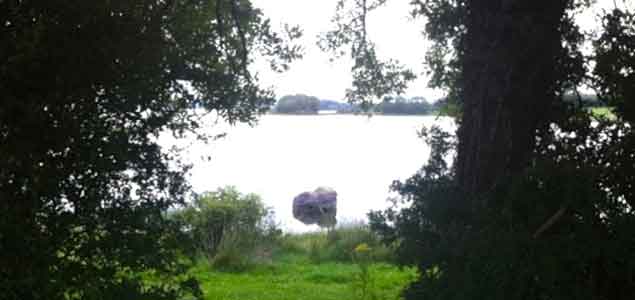 A long way from Concarneau.....Tom Dolan first discovered sailing on Lough Ramor.
A long way from Concarneau.....Tom Dolan first discovered sailing on Lough Ramor.
Even though the urge lay dormant in young Tom for his school years in Mullingar when Gaelic football and soccer took over his life, it was when he was 19 and at the outdoor activities education establishment Colaiste Dhulaigh, which is spread over four locations in Dublin and Malahide, that the sailing bug emerged again with an introduction to Glenans in Baltimore, and this time he was hooked for real.
Not only was he a natural sailor who was avid to learn more, but he proved to be a brilliant coach. There were others who realized that Tom Dolan was putting even more into sailing than he was taking out of it, and firm friendships were made, none firmer than that with Gerry Jones, who continues to live in Ireland where he has a busy working life. But he also acts as a voluntary agent for Tom, who in 2009 began to get involved in the sailing scene in France, and has steadily increased that involvement until he is now a leading figure in the Ministransat 650 programme.
It is by no means a gilded path he has chosen. Thirty million people in France may be closely interested in sailing, and they’ll take you to their Gallic hearts as you become part of their sailing scene. But the only sailing the Irish general public take much real interest in is the Olympics, and that’s when a medal may be in prospect. So an Irish rookie with very limited resources trying to get on the ladder in France – which is the only real ladder for high level offshore racing – has several mountains to climb.
But he knew what had to be done, and he knew how he could do it, for by this time he was being drawn into the 10-boat Minitransat community in Concarneau, which is well established as the CEMC (Centre d’Entrainement Mini de Concarneau). It sounds rather grand, but every cent has to be counted, and all involved are constantly looking for ways to increase income, maximise the boat’s performance, train and train again, and race.
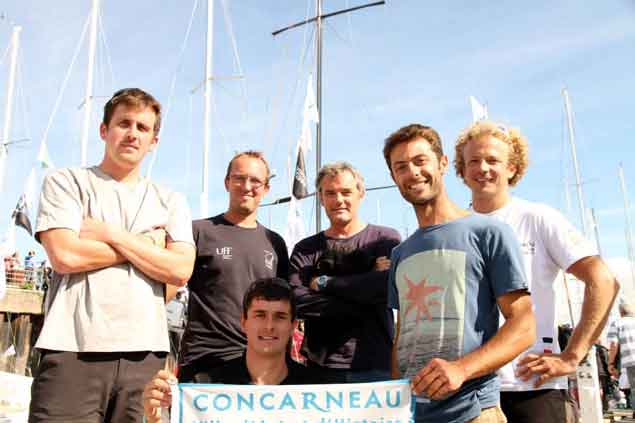 Members of the CEMC group at Concarneau, Tom Dolan on left
Members of the CEMC group at Concarneau, Tom Dolan on left
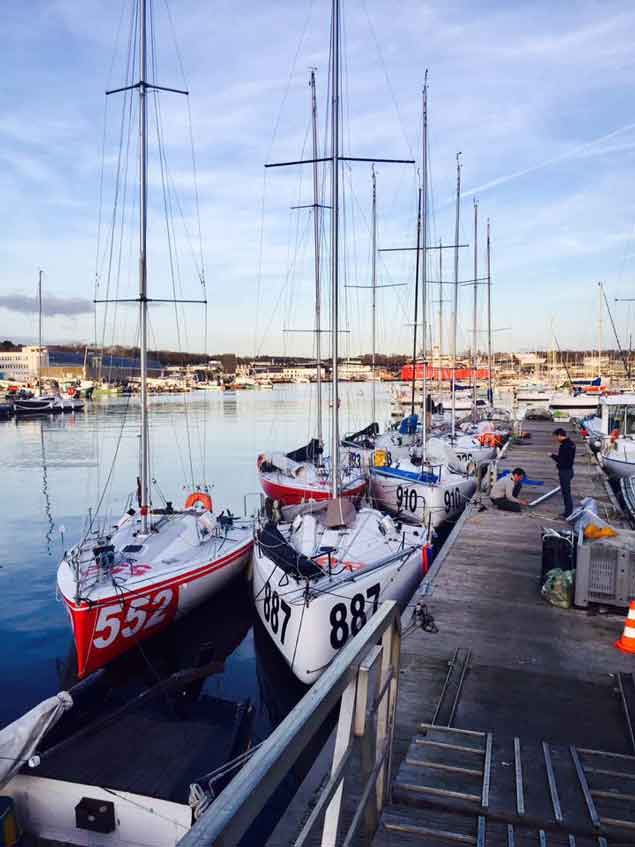 The Minitransat 650s of CEMC at Concarneau – Tom Dolan’s Pogo 650 Mark 3 (new in 2016) is number 910
The Minitransat 650s of CEMC at Concarneau – Tom Dolan’s Pogo 650 Mark 3 (new in 2016) is number 910
It’s worth it, as they have the great Gildas Mahe as coach, and last year every major race was won by one of the Concarneau group, including a victory for Tom himself. But getting to this level involved making a living doing deliveries and anything else involving high seas expertise, and using a borrowed Pogo 2 for his inaugural full season in 2015.
The Pogo 650 started life in 1995, and she’s now into Mark 3, one of the mainstays of the entire Minitransat scene. By 2015, the Mark 2 was off the pace, but Tom Dolan stuck at it to gain experience, and it was his father, with whom he’d shared those first sailing moments on Lough Ramor so many years ago, who made it possible to move on. For on his death in 2011, while the family farm was kept, he left Tom a modest legacy, and young Tom decided to blow the lot on getting involved with his own boat, and placed an order for the most basic available version of the Pogo 650 Mark 3.
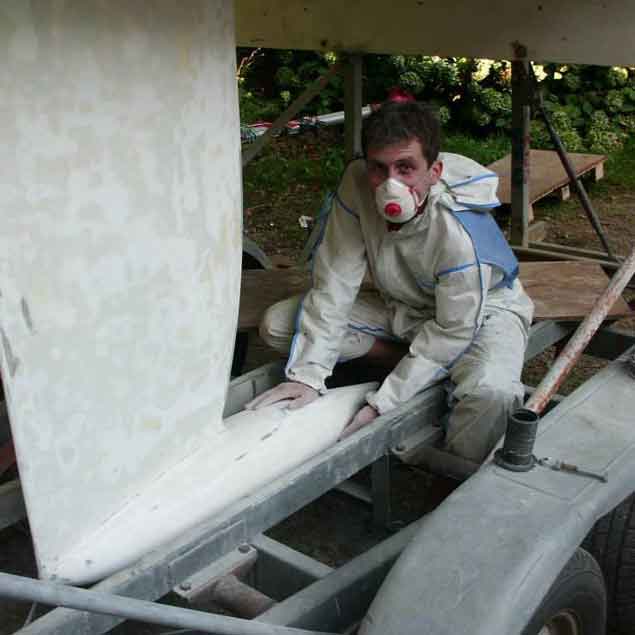 Tom getting the keel bulb perfectly faired. Members of CEMC expect to do most of their boat work themselves
Tom getting the keel bulb perfectly faired. Members of CEMC expect to do most of their boat work themselves
 Commissioning the new 2016 boat – IRL 910 – basically involved Tom in fully equipping a bare shell.
Commissioning the new 2016 boat – IRL 910 – basically involved Tom in fully equipping a bare shell.
He had much to do with installing electrics and equipment and just abut everything else from scratch before his new boat was ready to go racing in 2016, but it was well worth it, and by season’s end he was feted in the local press and internationally as “The Flying Irishman”. To keep the show on the road, he and his friend and fellow-skipper Francoise Jambou run their own 650 Training Centre which, with Tom’s brilliant coaching talents, provides a useful stream of income.
But as the sailing level escalates, so do the costs, and he’s very appreciative of sponsorship from home in the shape of Dubarry Ireland and Ding, while the strength of French interest in sailing generally is shown by support from Cellastab, Techniques Voiles, Renostye, Studio des Schizographes and of course his local pub, the Petite Bistro, where he’ll be celebrating the third place in the Pornichet Select 300 tonight, and maybe a toast to success in next Tuesday’s 500 miles race.
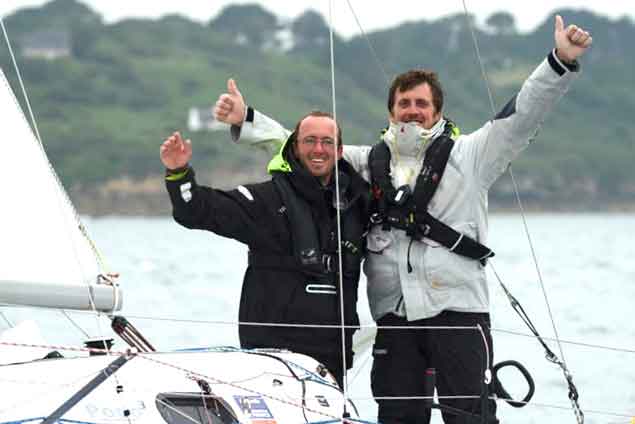 Tom Dolan (right) with sailing partner Francois Jambou celebrating victory with the new boat in a two-handed race.
Tom Dolan (right) with sailing partner Francois Jambou celebrating victory with the new boat in a two-handed race.
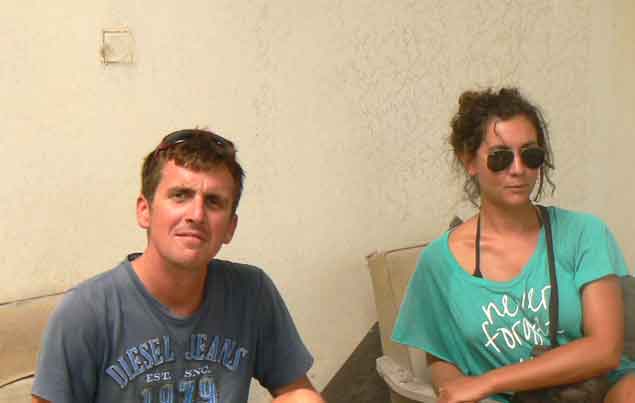 Tom from Meath and Karen from Lyons in Montserrat, where he’d sailed on a delivery voyage
Tom from Meath and Karen from Lyons in Montserrat, where he’d sailed on a delivery voyage
As for what it’s like being Concarneau-based on a year-round basis, even with the camaraderie and constant work and training of the CEMC, the winters can be long enough if you don’t line up a sunny delivery trip now and again. It was after one of these to the Caribbean and Montserrat that Tom met the significant other, Karen from Lyons, so now life back in Concarneau has a certain domesticity to it that was formerly lacking.
That said, domesticity is of a very rationed variety when you’re into sailing at this level, and Tom Dolan’s proposed programme for 2017 shows his level of commitment, and the continuing requirement for a solid sponsorship package, as the countdown to the Minitransat on October 1st at La Rochelle continues.
22nd April: Pornichet 350 Select (placed 3rd out of 52 boats)
May 9th Mini en Mai 500 miles
June 8th Trophee Marie-Agnes Peron
June 18th Mini Fastnet 600 miles (two-handed with Francois Jambou)
July 30th Transgascogne
October 1st Mini Transat (from La Rochelle)
Even as the programme is being implemented. Tom Dolan’s supporters behind the scenes are beavering away to put together a support package which will make the Mini-Transat a properly resourced challenge.
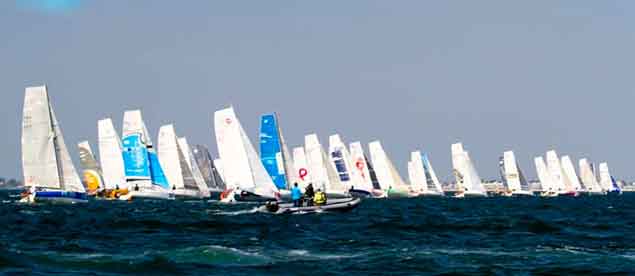 The contemporary French fleet of 52 actively-campaigned Mini 650s is an impressive sight on the starting line.
The contemporary French fleet of 52 actively-campaigned Mini 650s is an impressive sight on the starting line.
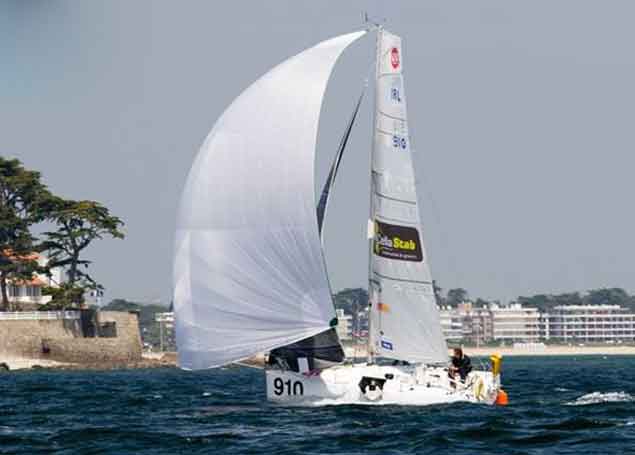 Getting clear and getting ahead – IRL 910 departs Pornichet
Getting clear and getting ahead – IRL 910 departs Pornichet
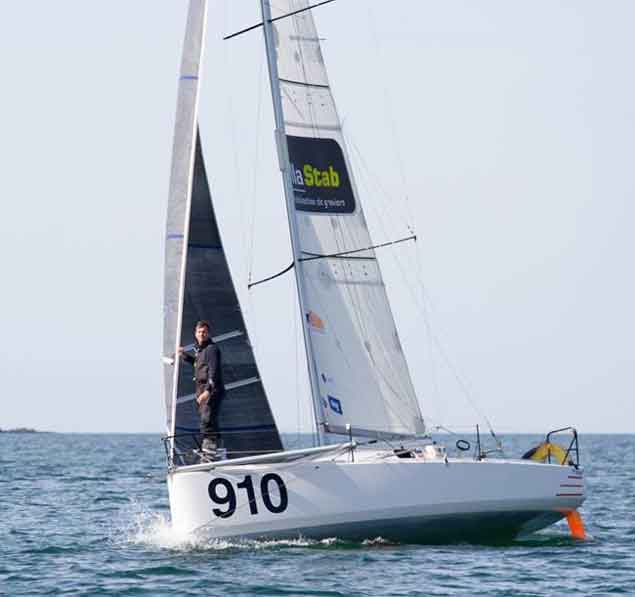 After being in the lead within five miles of the finish of the 300-mile Pornichet Select on April 26th, Tom Dolan in IRL 910 had to be content with third in the fleet of 52 at the finish.
After being in the lead within five miles of the finish of the 300-mile Pornichet Select on April 26th, Tom Dolan in IRL 910 had to be content with third in the fleet of 52 at the finish.
And beyond that? Team Tom Dolan are very interested in the confirmation of a decision which is expected to come from the Mid-Year Meeting of the World Sailing Council which is currently under way in Singapore (from May 5th to May 9th). Before it is the final acceptance of an invitation from the International Olympic Council to World Sailing to propose Showcase Events to be held alongside the Sailing Olympiad 2020 in Tokyo to demonstrate the potential of both kiteboarding and offshore racing to be Olympic events.
For offshore racing, the proposal is already taking shape for a 9-12m totally One-Design boat, to be raced two-handed, the fleet for the Showcase Event at Tokyo being envisaged at 18 to 20 boats. It’s emphasized that this is only a showcase, it’s not real Olympics. But it could be a guide for the future, and we’ve no doubt that if such an event were to be held in 2020 beside the Olympics, the participants would regard it as very much for real.
It’s certainly of considerable interest to Tom Dolan and his team, for they’re very aware that you’re in a different league in Ireland when you’re trying to raise support for an Olympic campaign rather than something which is seen as more of a niche interest.
But quite what your traditional offshore racer, setting off in their favourite ISORA or RORC event, will think of the prospect of their beloved sport being sucked down into the Olympic maelstrom is something else altogether - a topic for another day
The Lymington (UK) based Rating Office, headquarters of the world's most popular rating system IRC, is to be managed by Dr Jason Smithwick. Following on from academia, roles in the research industry and sailing's international federation Smithwick will take up his post at the head of a team of four full-time staff and several external consultants on 3rd July this year.
Established in 1974 the Rating Office has been coordinating the measurement of sailing boats and the issuing of rating certificates for over 43 years. Regarded by many as 'the centre of excellence for yacht measurement' it is one of very few mythical buildings in the world of sailing. The work that has been done inside its four walls over the years, producing ratings and handicaps for sailing boats of all shapes and sizes so as to race equitably over long and short courses, is the foundation piece of a huge multi-billion pound international sport and its associated industry. Over the years the Rating Office staff have been coordinating the measurement and rating of everything from IOR boats in the '70s and 80's, IMS in the early '90s and CHS in the '80s and '90s which evolved into IRC in use today.
In addition to calculating ratings the office is involved in the management, measurement and in some cases, the creation of class rules for fleets such as the Whitbread 60, the current VOR 65, the new Club Swan 50, Swan 45 class, Mumm 30 and Mumm 36 classes, Nautor Swans, Wallys, Maxi 72 and countless other sub-groupings that use the IRC Rule today. The Rating Office is also actively involved in international safety standards for yacht racing and has key roles in RYA and World Sailing working groups and committees.
Dr Jason Smithwick (45) graduated from Southampton University in 1994 continuing in the world of academia for another 10 years gaining his doctorate and eventually ending up as Principal Engineer & Software Manager at the world renowned Wolfson Unit. The next stage in his career was in the role of Technical and Offshore Director at sailing's international federation, known today as World Sailing.
"The role of Director of Rating is something that completely fits my experience and passion. Racing yachts, numbers and the greater racing community is what gets me out of bed in the morning. This is a dream job and I am honoured to follow in a long line of individuals that have handled this foundation piece of the sport of yacht racing and continue the important work that has been done by my predecessors and their colleagues," said Dr. Smithwick.
With rating rule stability in a dynamic technological age owners, clubs, sponsors and the marine industry at large can continue to invest with real confidence in the sport of sailing.
"I'm really pleased to find someone of Jason's experience and technical knowledge to head up the Rating Office in Lymington. The importance of the role played by the Rating Office staff over the years cannot be overstated. By calculating ratings and issuing rating certificates the foundation for equitable racing between disparate boats is established. This in turn enables many thousands of sailing boats to populate regatta and club race courses the world over. Jason's appointment will give IRC especially, and the sport in general, stability and real confidence for the future," said Eddie Warden Owen, RORC Chief Executive and Interim Rating Office Director
Giant International Yachting Gathering for Fastnet Race
August's Rolex Fastnet Race remains on track for a record-sized fleet. Currently 390 boats are entered: 338 competing for the main IRC handicap prize; the remainder racing for their own trophies in the Class40, IMOCA 60, Volvo Ocean 65 and Multihull grand prix classes.
This line-up makes the race the world's largest offshore race in terms of competitor numbers. Its entries are the most diverse, ranging from maxi-multihulls to the world's fastest monohulls, including those that compete in the fully crewed and singlehanded round the world races, to the racer cruisers and cruiser racers that form the majority of the IRC classes.
The fleet is also the most international. At the present tally, boats from 25 nations will be heading west down the Solent from Cowes on start day, Sunday 6th August.
As expected, the largest entry is from the UK with 58% of the fleet, but this means that 42%, or a whopping 164 boats, will have come from overseas.
France has dominated Rolex Fastnet Race results in both the IRC and non-IRC fleets in recent years and once again is back with a vengeance with the second largest entry, representing 13% of the fleet, followed by the Netherlands, Germany and Ireland with 7, 5 and 4% respectively.
Several teams will be making the journey from the furthest corners of the globe especially for the Rolex Fastnet Race. One of the most impressive efforts is from the Australian trio. This includes Finnish former Whitbread Round the World Race skipper Ludde Ingvall with his heavily remodelled Rolex Sydney Hobart Race line honours-winning maxi, CQS (ex-Nicorette). In her latest incarnation, this boat has been lengthened to 100ft and is futuristic-looking with a low volume reverse sheer bow, deck wings to increase her shroud base and a Dynamic Stability Systems lateral foil arrangement.
Also from down under, Rupert Henry's Judel-Vrolijk 62, Chinese Whisper will be back on familiar waters: She was previously Sir Peter Ogden's all-black 62ft Mini Maxi, Jethou. She is joined one of the most famous 'classic' maxis, Kialoa II, the elegant 73ft aluminium S&S design, enthusiastically raced by American Jim Kilroy from 1963-1973, when she won both the Transpac and Sydney Hobart races. She is now campaigned by Patrick Broughton.
As usual there are strong entries from the USA led by George David's Rambler 88 and Privateer, Ron O'Hanley's Cookson 50 competing a decade on from when Ger O'Rourke's sistership, Chieftain, won overall.
This year's race has its largest ever Asian entry with boats coming from Korea, Japan and China.
In the Class40, Japan's Hiroshi Kitada returns to the UK with his Pogo40 S3, Kiho, having competed in the Transat bakerly and Quebec-St Malo races last year.
From China is Ark323, skippered by Li Yun. This Botin & Carkeek-designed TP52 (ex-Sled/Warpath), in 2015 became mainland China's first entry with an all-Chinese crew in the Rolex Sydney Hobart. The boat is now making the long haul to the UK to compete in another of the internationally renowned 'classic 600 milers'.
Korea's first entry in the Rolex Fastnet Race comes in the form of the GP42 Sonic. Campaigned by Andrew Rho, Sonic has been one of the most competitive teams in Korea's burgeoning big boat racing scene.
Russia is becoming an increasingly major player in international yacht racing and will be fielding at least three entries including Pjotr Lezhnin Racing in the Class40, while in the IRC fleet is Sergei Zhedik's Sunfast 3600 Voyager and Igor Rytov's JPK 10.80 Bogatyr. Rytov competed in the last Rolex Fastnet Race as a crewman and, according to the Bogatyr team's Ivan Sharapov "he thought there was room for improvement, so he is doing it again on his own terms with a crew he's selected." Rytov acquired a JPK 10.80 following the victory of Géry Trentesaux's sistership Courrier Du Leon, in the last Rolex Fastnet Race.
Following on from its MOD70 entry in previous years, Oman Sail returns to the Rolex Fastnet Race this time in the Class40 fleet. Once again the crew will be led by French round the world sailor Sidney Gavignet who is spending this season coaching up top Omani sailor Fahad al Hasni in shorthanded offshore racing.
From the eastern Mediterranean, the race has a Turkish entry in Yigit Eroglu's First 35 F35 Express, while following the successful debut with Team Israel in last year's Brewin Dolphin Commodores' Cup, Omer Brand is returning with another Israeli crew, this time aboard Richard Loftus' Swan 65 and long serving competitor, Desperado. Brand and his crew will have to get used to some ancient Desperado traditions such as the black tie dinner at the Fastnet Rock not to mention the team's pet gorilla, Joe Powder.
"It is brilliant to see such a diverse fleet with huge international representation," says RORC CEO, Eddie Warden Owen."The Rolex Fastnet race is recognised worldwide as one of the most challenging 600 mile offshore races. It combines the tidal challenges of the Channel, with headlands to negotiate on the English South Coast, with open ocean racing in the Celtic Sea going to and from that iconic landmark, the Fastnet lighthouse off southern Ireland. Add to these navigational challenges typically unpredictable English weather which tests the seamanship and stamina of all the crew. This is why serious offshore sailors from all over the world want to take part."
RORC 2017 Season's Points Championship Preview
Over 500 yachts are taking part in the 2017 RORC Season's Points Championship. Over 5000 sailors from all over the world will race in the biggest offshore sailing competition in the world. While this year the 2017 Rolex Fastnet Race is the showcase event, there are fourteen testing races that make up the championship, and every race has its own coveted prize for the overall winner and for class honours. For 2019 a second Irish race is hoping to be added to the series.
The 2017 RORC Season's Points Championship destinations include the Caribbean islands of Antigua and Virgin Gorda, plus the Spanish island of Lanzarote. There are seven European destinations: Belgium, France, Great Britain, Guernsey, Ireland, Malta, and the Netherlands. Five races are to count for Class Honours and the highest total score will designate the winner Overall racing under IRC.
RORC Commodore, Michael Boyd from Dublin's Royal Irish Yacht Club will be racing Lisa, in IRC One. Owned by Suzi and Nick Jones, the British Bénéteau 47.7 was last year's overall winner with Michael Boyd taking part in a number of races, including the Round Ireland, with the team.
"The RORC Season Points Championship is seriously difficult to win especially in a Rolex Fastnet year when there are many boats and the competition is tough. This year, I have chartered Nick and Suzi Jones’ Lisa and we have put a squad together to take up the challenge and it is going to be hard to win again.” commented Michael Boyd. “This will also be my last season as Commodore of the RORC and I wish to pass on the honour with the club in good health. One of my key goals is to increase the activities of the club internationally. Over a third of our club members are from overseas and we have yachts racing under the club's IRC rating rule all over the world. The Rolex Fastnet Race is one of the great races to win but to win any of the RORC races throughout the championship will a moment to savour.”
Cervantes Trophy Race
Start: 29th April, 2017
Course: Squadron Line, Cowes – Le Havre
Distance: 110-160 miles (Channel Marks may be included).
The first European race of the 2017 RORC Season's Points Championship will be the Cervantes Trophy Race, 100 yachts are expected to start from the Yacht Squadron Line.
Dutch Grand Master, Piet Vroon is back, as skipper of Ker 51, Tonnerre 4, taking another tilt at the championship in IRC Zero. In IRC One, Alan Hannon's RP45, last year's Best Overseas Yacht will be racing. In IRC Two, Michael Boyd's Lisa is the highest rated boat, and sees Gilles Fournier's French J/133 Pintia as one of the teams to beat.
“The Cervantes Trophy is our first race of the season and we will discover how good the competition is.” Commented Gilles Fournier. “We aim to do well in our class, as for the overall, luck is always an important factor. The Rolex Fastnet is attracting a big fleet, so winning our class as we did the last two years will not be easy.”
In IRC Three, a huge variety of yachts will be competing from elegant Swans to lightweight JPKs. With such a diversity in the fleet, the weather will play a crucial part in favouring races for displacement yachts such as Ben Morris's Swan 55 yawl, Lulotte and light weight flyers like Richard Palmer's JPK 10.10 Jangada. The armed forces will do battle in J/109s, the Royal Armoured Corps’ Ajax and the Royal Navy Sailing Association's Jolly Jack Tar are bound to have a close conflict.
Frers 45, Scaramouche will be sailed by the Greig City Academy, to kick off their Rolex Fastnet campaign The school from Harringay, London will become the first State School to enter the Rolex Fastnet Race, if they complete their qualification requirements. Four Sixth Formers have received their RYA Day Skipper qualification and the rest of the crew will be selected after taking their RYA Day Skipper Course. Half of the crew must now race 300 miles to qualify and there are First Aid and Offshore Special Regs Requirements.
Gregg School pupil, Shabazz Patterson, is excited about the chance to race in the Rolex Fastnet:
“It’s a big challenge for us. You have to be alert all the time on deck, everything can be still with no other boats in sight and then there will be a sudden change in the direction of the wind and it all becomes very intense as you tack to change course. We’ll be working in shifts over the four days. You think you won’t sleep between shifts, especially if it’s choppy, but as soon as you get into the berth you fall asleep because you’re just so physically tired.”
Seven Class40s will be racing to Le Havre, including RORC Transatlantic Race winners, Halvard Mabire and Miranda Merron in Campagne de France. (Arthur Daniels/RORC)
IRC Four is expected to be the largest class racing for the Cervantes Trophy, last year's class winner Noel Racine's French JPK 10.10 Foggy Dew has the highest rating in the class for the Cervantes Trophy. Previous Cervantes Trophy winner, Winsome skippered by Harry Heijst, will be hoping for suitable heavy weather to challenge the lighter displacement yachts. 20 teams will be racing in the gutsy IRC Two Handed Class with a fleet of seven short handed Class40s also entered, including RORC Transatlantic Race winners, Halvard Mabire and Miranda Merron in Campagne de France.
Speaking on behalf of the Société des Regates du Havre, Christophe La Chevre promises a warm welcome in Le Havre for the finishing teams. “All competing sailors will be very welcome with free dockage for 24 hours. The club will stay open all night on Saturday. I recommend booking a table for Sunday lunch (+33 235 412100 email: [email protected]). The restaurant has a very beautiful view. It is also the 500th birthday of Le Havre City, so there are many things to explore.”
Fifty Cruiser Racers Compete At RORC Easter Challenge
Across the 50 boat fleet competing at the RORC's three day long domestic season opener, that doubles as its annual training regatta, it was close across most classes, but none more so than IRC One writes James Boyd. In this, Mike Greville's sparkling Ker 39, Erivale III managed to lose her three point lead in yesterday's opening round the cans race and the victor was only decided on the final, head down, charge for the finish line in race two.
Three races were scheduled Sunday, but the wind dropped as the new breeze attempted to settle towards the end of the first race, causing the course to be shortened for IRC Two and Three. With the wind shifting dramatically, it took three attempts to get what was to be the second and final race underway.
Within IRC One, there was a match race between the two Mark Mills-designed MAT 1180s. Tor McLaren's two week old Gallivanter got its first taste of glory, winning today's opening race, However sistership, Christian Zugel's Tschuss, finished seven points ahead overall.
Star performer throughout the regatta was Sir Keith Mills' Invictus in the FAST 40+ class, racing within IRC One. With a 1-3 today, the black Ker 40+ won the regatta by a mighty 11 points. However it was not easy and all five of the FAST 40+ had their moments with Tony Dickin's Jubilee looking particularly strong today, leading the opening stages of race two, which was eventually won by Mark Rijkse's 42° South.
In IRC Two, a late charge from RORC Admiral Andrew McIrvine on La Reponse was enough to get his First 40 onto the podium but not enough to make an impression on the race for the lead between David Franks' JPK 10.10 Strait Dealer and Redshift Reloaded, the Sun Fast 3600 belonging to Ed Fishwick
Full results here
Time was when the Dun Laoghaire to Dingle Race was promoted as a handy way to position your little old cruiser in West Kerry to be nicely placed to make her way in gentle hops back to her home port on the south or east coast, ambling in leisurely stages along one of the finest cruising grounds in the world writes W M Nixon.
It was envisaged primarily as a sort of enlarged club race, the club setting the tone being the National Yacht Club in Dun Laoghaire. There, enthusiastic members and Dingle race plotters Martin Crotty, Peter Cullen and Brian Barry added a further attraction when promoting the first race, as it drew nearer in 1993, by suggesting that real dyed-in-the wool cruising types might find the race of interest if they were thinking of continuing with a clockwise cruise on round Ireland.
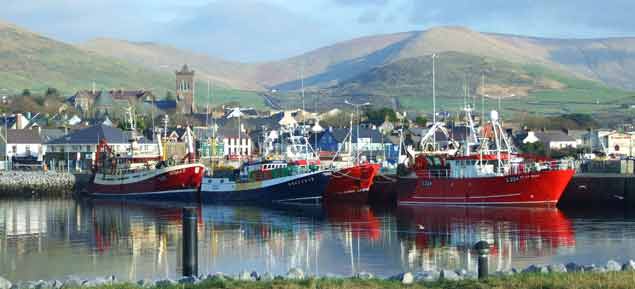 Dingle Harbour makes for an attractive destination...
Dingle Harbour makes for an attractive destination...
 …while its marina is enticing for cruisers and racers alike
…while its marina is enticing for cruisers and racers alike
Lovely idea. But so far as I know – though it’s very much hoped that I’ll be rapidly informed otherwise – it is this goggle-eyed wordsmith focused on his ancient computer screen who is still the only cruiser-racer skipper who has completed the Dun Laoghaire to Dingle Race, and then cruised on round Ireland.
We did it in handy stages, leaving the boat in Dingle for ten days after the race was completed to return home to the word-production coalface, then going on to leave her on a mooring we’d laid at Arbear at the head of Clifden Bay after we’d cruised the Aran Islands and Connemara in detail, followed by another return home for the manufacture of merchandisable verbiage. Then the third stage was home to Howth round the top, with Donegal doing its best to rival Kerry for dramatic scenery.
However, that was all a very long time ago. In fact, it was so long ago it was the first time I’d sailed with a proper pair of Dubarry Shamrock Goretex boots. I’d previously had an experimental leaky pair from a different manufacturer with which I’d persisted for years, so I can still remember the sheer joy of dry warm feet whatever the weather after the genuine Dubarrys had been deployed.
But enough of such ramblings - even if it does serve to remind us of the way the Dun Laoghaire to Dingle Race has become a much-loved part of our sailing world. And as for the reason for people not cruising on round Ireland when being in Dingle leaves them so handily placed for continuing the circuit - the answer is simple. The fact is that the course of almost 300 miles has taken them as swiftly as possible past some of the most glorious cruising places in Ireland, and the only way the skipper can keep his shipmates plugging on is by swearing on all that is holy that they’ll cruise gently back the same way in a much more civilised style.
In such circumstances, you’re whistling against the wind in trying to sell the coast of Connacht as the more interesting way to get home. Yet from an early stage, even the notion of the Dingle dash as having a strong cruising orientation hasn’t really held up for a significant part of the entry. People go into it with every intention of winning, and the talk of conveniently positioning the boat for a spot of cruising in Kerry and West Cork has only been smoke and mirrors.
![]() The Yellowbrick record of the Dun Laoghaire-Dingle Race in 2015. Sometimes the fleet has been even more widely spread than this
The Yellowbrick record of the Dun Laoghaire-Dingle Race in 2015. Sometimes the fleet has been even more widely spread than this
The pace was set from the off in 1993, when the winner was Richard Burrows’ Sigma 36 Black Pepper. In subsequent years, she was cruised to Greenland and other Godforsaken spots in the ownership of fellow Malahide sailor Peter Killen, so Black Pepper has a boat history which must make her the best-used Sigma 36 ever. Certainly for the Dingle dash of 1993, skipper Burrows shipped aboard the formidable talents of Peter Wilson and Robert Dix as the main occupants of the driving seat, and Black Pepper had a wellnigh perfect race.
That said, at the riotous prize-giving afterwards – the Dingle prize-giving is always riotous, just relax and enjoy it – Black Pepper’s skipper gave a wildly funny speech which he rounded out by presenting Robert Dix with the Golden Blanket Award. As to what was meant by that I haven’t a clue, so you’ll have to ask Dixie himself. But as he has been winning major awards of every kind since 1970 when he became the youngest ever Helmsmans Champion, the Golden Blanket goes well in his trophy cabinet.
With the first race off to such a humdinger inauguration, the vision of the founders had been justified. Well, perhaps “vision” is overstating it. At this week’s launching of the 2017 staging, which will be on June 14th, longtime organiser Martin Crotty revealed that the idea of the Dingle Race came about almost by misadventure.
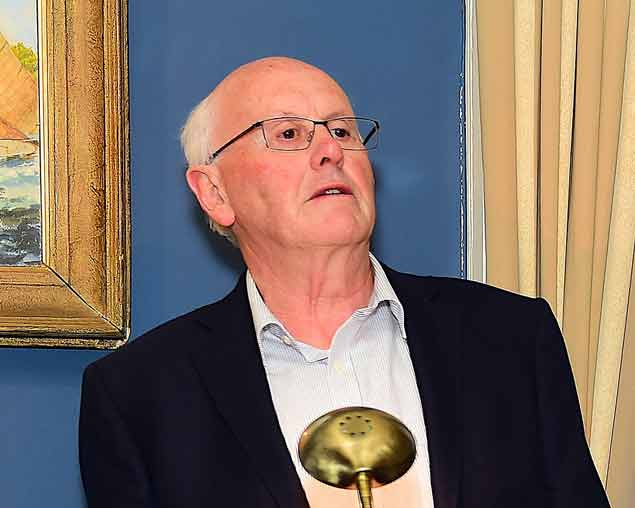 The founding Dingle Race organiser Martin Crotty reminiscing about the early days in 1993 at this week’s reception in the National Yacht Club. Photo Michael Chester
The founding Dingle Race organiser Martin Crotty reminiscing about the early days in 1993 at this week’s reception in the National Yacht Club. Photo Michael Chester

He and fellow owner Peter Cullen had been doing the 1992 Round Ireland Race with their hefty Sigma 41 Koala, and in slugging up the west coast into a particularly unpleasant northerly (I remember that one too), their mainsail went into several pieces on the latitude of Loop Head, so they retired and ran back to Dingle, a place they didn’t know at all.
They got to know it very well indeed over the next day or two, and the hospitality the little West Kerry port meted out to them – with the Dingle Skellig Hotel more or less providing open house – soon got them thinking that a race there rather than sailing all the way round the Emerald Isle would be an interesting alternative in the years when the biennial Round Ireland Race from Wicklow was not being staged.
Such ideas seem marvellous over a pint or three as midnight draws on, then fade from the memory. But there was some special chemistry already at work between the can-do Dun Laoghaire sailors and the maritime-minded folk of Dingle. Perhaps it’s because both ports think they’re the hub of the universe…… Whatever the secret ingredient, by 1993 in Dingle Harbour, Master Brian Farrell was ready to welcome the fleet, a new marina was in the making, and Dingle was on the cusp of an entirely new era.
 Dingle in the far west of Kerry has formed strong links with Dun Laoghaire in Dublin Bay, yet the two places could not be more different.
Dingle in the far west of Kerry has formed strong links with Dun Laoghaire in Dublin Bay, yet the two places could not be more different.
As for the Dun Laoghaire to Dingle Race, we knew it was fully part of the scheme of things by 1995, as Denis Doyle turned up to compete with Moonduster. Once that happens, you know your race has arrived, and “The Doyler and The Duster” were honoured participants for many years, encouraging some very substantial boats to subsequently take part, with new heights being reached in 2009 when Michael Cotter’s handsome 78ft Whisper brought a touch of global glamour and a new record, though she missed the magic 24 hours by 43 minutes and 45 seconds.
As each race succeeded its predecessor, a bonus emerged when it was acknowledged that the Dun Laoghaire to Dingle would count as a qualifier for the Fastnet Race, which would as usual be staged about eight weeks later. By this stage the race had so much going for it that it seemed impervious to setback, but like everything else in Irish life, it went through diminished times during the recessionary years.
 When “The Doyler and The Duster” (Denis Doyle and Moonduster) became involved from 1995 onwards, the Dun Laoghaire to Dingle race was made. This is a page from the August 199 Afloat magazine, with Moonduster much in evidence in the race report. The winner that year was Donal Morrissey’s GK34 Joggernaut from Galway, and in those days the start was in Dun Laoghaire Harbour.
When “The Doyler and The Duster” (Denis Doyle and Moonduster) became involved from 1995 onwards, the Dun Laoghaire to Dingle race was made. This is a page from the August 199 Afloat magazine, with Moonduster much in evidence in the race report. The winner that year was Donal Morrissey’s GK34 Joggernaut from Galway, and in those days the start was in Dun Laoghaire Harbour.
But then came 2015, and the numbers were back up, and then some. Having seen his pet project through times good and bad, Martin Crotty had indicated that this 12th Dun Laoghaire to Dingle Race would be the last he would personally administer, but already a strong successor was being briefed in the person of Adam Winkelmann. And in the 2015 race he had a vintage familiarisation to observe how it all worked, though as his mother Carmel was for many years one of the time-keepers, he started from a position of inside knowledge.
Over the years, the Dingle Skellig Hotel, which showed such generosity to the sea-battered crew of Koala way back in 1992 – leading to the inception of the race – has stayed on board as co-sponsor, and everyone’s longterm faith in the event was born out in 2015’s race, which was a classic. Before it, the atmosphere around the National Yacht Club was pure carnival, and while the start may have been slow, the winds soon filled in from the north and the fleet scampered down the east coast.
Out in front, the line honours battle was between Adrian Lee’s Cookson 50 Lee Overlay Partners from Dun Laoghaire and Anthony O’Leary’s Ker 40 Antix from Cork, and they went so well that for a while it looked like Antix might get the corrected time win. But holes in the wind at the Fastnet and beyond shook up the order, and by the finish it was glory day for J Boats, with the Shanahan family’s J/109 Ruth (NYC) winning by 20 minutes from her Pwllheli-based sister-ship Mojito (Peter Dunlop & Vicky Cox), the first foursome being very complete for the Johnstone brothers as the J/122 Aurelia was third and the J/109 Dear Prudence was fourth.
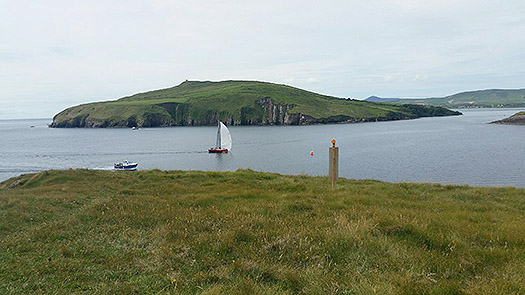 Anthony O’Leary’s Ker 40 Antix crossing the finish line at Dingle in 2015
Anthony O’Leary’s Ker 40 Antix crossing the finish line at Dingle in 2015
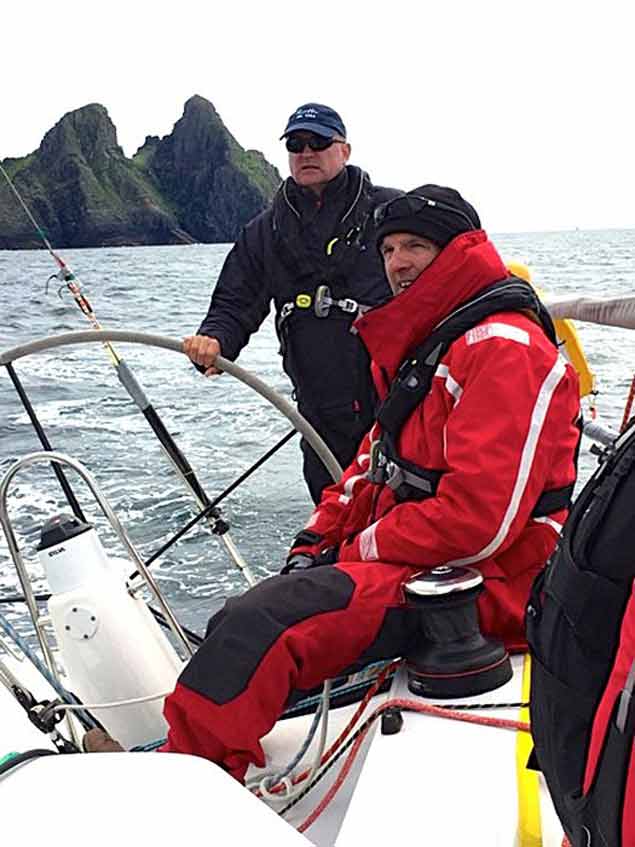 Overall 2015 winner Liam Shanahan at the helm of his J/109 Ruth with Skellig Michael put astern, and crewman Kevin Daly trimming the main for the final stage up Dingle Bay to the finish.
Overall 2015 winner Liam Shanahan at the helm of his J/109 Ruth with Skellig Michael put astern, and crewman Kevin Daly trimming the main for the final stage up Dingle Bay to the finish.
 After a rugged race, there’s nothing like an al fresco party at Dingle
After a rugged race, there’s nothing like an al fresco party at Dingle
But in a fascinating contest, almost every boat was having her day at one stage or another, and for those who were doing the race as a Fastnet qualifier, it came up trumps. Irish Offshore Sailing’s 36ft Jeanneau Desert Star may have only been in the middle of the fleet in the Dingle results, but her crew were on a learning curve and on top form by the time they did the Fastnet Race, so much so that they won overall in the 33-boat fleet making up the Sailing Schools Division, a well-earned dream result for skipper Ronan O Siochru.
So Martin Crotty handed over a prestigious event in really good order to Adam Winkelmann after all the D2D business was done and dusted in 2015, and this week’s launching reception in the National Yacht Club for what is now the Volvo Dun Laoghaire to Dingle Race was one of those gatherings which ticked so many boxes that we could get a month’s worth of Sailing on Saturdays out of it.
The heartwarming sense of continuity was palpable. Not only was Adam Winkelmann taking over the D2D from Martin Crotty, but in the host club, Ronan Beirne had been barely a wet week as the new Commodore in succession to Larry Power. To say that the speeches were in tune with the mood of the evening barely gets the flavour of it. It was a time for nostalgia, a time for relishing the present, and a time for keenly anticipating the future, with all aspects covered.
 Adam Winkelmann, chair of the Volvo Dun Laoghaire Dingle race Committee, reveals his hopes for 2017’s race and the races beyond. Photo: Michael Chester
Adam Winkelmann, chair of the Volvo Dun Laoghaire Dingle race Committee, reveals his hopes for 2017’s race and the races beyond. Photo: Michael Chester
It was Adam Winkelmann who summed it all up in a friendly presentation – he does it so painlessly that the word “speech” is way too pompous – effortlessly telling us about the new dynamic with the lineup with Volvo, the continued support from Dingle with the Dingle Skelligs Hotel joined by Crean Brewery – and the growing interest from the RORC with that club’s Janet Grosvenor – a very good friend to Irish offshore racing – planning to monitor the Volvo Dun Laoghaire to Dingle Race 2017 with a view to giving it greater recognition in the RORC’s 2019 programme.
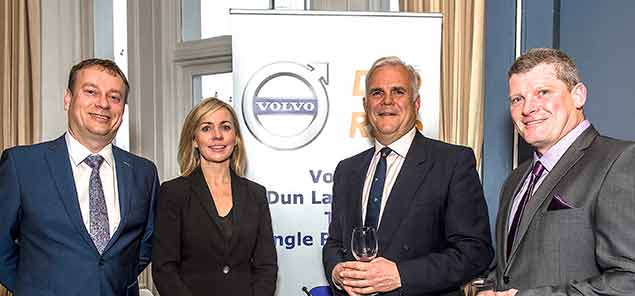 Graham Fitzgerald of the Dingle Skellig Hotel, Patricia Greene of Volvo Car Ireland, Adam Winkelmann, and Jerry O’Sullivan of Crean Brewery, Dingle. Photo Michael Chester
Graham Fitzgerald of the Dingle Skellig Hotel, Patricia Greene of Volvo Car Ireland, Adam Winkelmann, and Jerry O’Sullivan of Crean Brewery, Dingle. Photo Michael Chester
As it is, the 2017 race will start on the evening of Wednesday June 14th, which research among competitors has show is reckoned as the most user-friendly time for those fitting the race into work breaks, as it means you can definitely do a three day week, yet have every chance of making the clock-in at the workplace first thing Monday morning.
Thus the prize-giving will be on Saturday night, and it is being moved beck to the Dingle Skelligs’ sister establishment, Benners Hotel in the heart of town. As for the bigger picture, the timing also allows a useful gap before the Sovereigns Cup series starts at Kinsale on June 21sr, but while the start time will be tight for anyone who also plans to also do the ICRA Nationals at Crosshaven from Friday June 9th to Sunday June 11th, in times past we’d have reckoned that’s it a logistical challenge which is do-able, you just draw lots for the three guys who are going to take the boat to Dun Laoghaire as soon as the last race at Crosser is over.
As if that’s not enough of a challenge, Ric Morris has lately been airing a suggestion that it’s time to think seriously about an Irish National Offshore Championship based around the many events already in existence. He reckons that with the Round Ireland and the Dun Laoghaire to Dingle races alternating at the peak of this annual season-long series, we’d have an intriguing setup which has the potential to involve many boats – and he means many big time.
Certainly the imprimatur of the RORC on the Volvo Dun Laoghaire Dingle Race would give it turbo power, making it a serious points accumulator apart from being a superb race in its own right. Truly it has moved on a long way from being a handy little club-oriented event best used to position your boat in Ireland’s finest cruising ground. But we shouldn’t be surprised, when we remember that the Fastnet Race itself started in a very modest way in 1925. It was so shunned by the sailing establishment that it couldn’t get a starting line at Cowes, and had to be sent eastward out of the Solent from the start line of the Royal Victoria Yacht Club at Ryde.
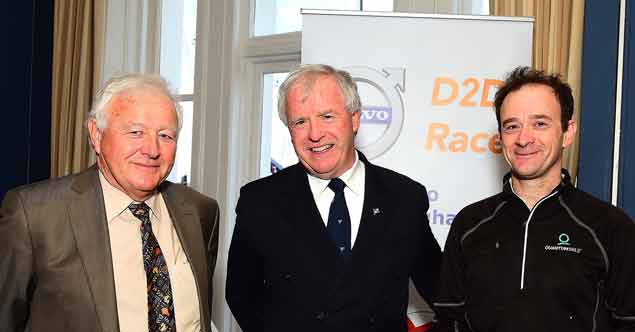 Brian Farrell, Harbour Master of Dingle when the Dun Laoghaire-Dingle race was inaugurated in 1993, Ronan Beirne the newly-elected Commodore of the National Yacht Club, and Yannick Lemonnier, who will be racing a Minitransat 650 to Dingle. Photo Michael Chester
Brian Farrell, Harbour Master of Dingle when the Dun Laoghaire-Dingle race was inaugurated in 1993, Ronan Beirne the newly-elected Commodore of the National Yacht Club, and Yannick Lemonnier, who will be racing a Minitransat 650 to Dingle. Photo Michael Chester
Presumably the RORC still sends the RVYC an annual Christmas card as a token of their appreciation of that display of faith way back in 1925, now that the hugely popular Fastnet Race is started from all the glory of the Royal Yacht Squadron line at Cowes.
And as for the Dun Laoghaire-Dingle Race in all its manifestations, while it has always been comfortably under the imprimatur of the National Yacht Club in Dun Laoghaire, the developing positive attitude towards sailing at official levels in Dun Laoghaire/Rathdown was underlined by the official presence at Tuesday’s gathering of Councillor Cormac Devlin, Cathaoirleach of Dun Laoghaire/Rathdown County Council.
But while the new turbo power of the Volvo Dun Laoghaire to Dingle Race was quietly in evidence at the party in the National YC this week, it was good to meet up with old friends from Dingle from the earliest days, particularly the former Harbour Master Brian Farrell whose enthusiasm for his job always went way beyond the call of duty.
There too were Brian Barry and Peter Cullen, both of whom did so much to put the show on the road and keep it there through times good and bad. But it was appropriate that also present was the one and only Yannick Lemonnier, who did the race in the two-handed division in 2015 (he was second to Howth’s Colm Buckley and Simon Knowles) but in 2017 will be doing it in a new special division which has been encouraged into the fray by the National’s Sailing Manager Olivier Prouveur.
Yes indeed – the Volvo Dun Laoghaire to Dingle race will be providing a start for Mini 650 boats, and Yannick Lemonnier will be right in the thick of it all. They’ll get a separate prize and won’t be in the IRC Division, but it’s a new twist in a race which, in 2017, will also have a new old twist.
 David Thomas, MD of Volvo Car Ireland, with Emma O’Carroll, also of Volvo Car Ireland, and Darryl Hughes, owner-skipper of Maybird, the first gaff-rigged entrant in the Dingle Race. Photo Michael Chester
David Thomas, MD of Volvo Car Ireland, with Emma O’Carroll, also of Volvo Car Ireland, and Darryl Hughes, owner-skipper of Maybird, the first gaff-rigged entrant in the Dingle Race. Photo Michael Chester
For no-one has any recollection of the Dun Laoghaire to Dingle Race ever having a gaff-rigged entry in its 24 years. Yet the madly enthusiastic Darryl Hughes has entered his beautifully-restored 1937 Tyrrell-built 43ft gaff ketch Maybird. He knows he’ll be doing quite well to make it to Dingle in time for the prize giving. And then he’ll have to think of further schedules, as he is also entered for the Classics Division in the Volvo Dun Laoghaire Regatta from July 9th to 12th. But in the National this week this week he was able to assure everyone that Maybird is already well n the way to being race ready. Sure hadn’t he and his mates scrubbed her and anti-fouled her – including a fresh boot-top – all on the one Spring tide at Poolbeg a couple of weeks ago? So the count-down is already well under way for the turbo-powered Volvo Dun Laoghaire-Dingle Race 2017.
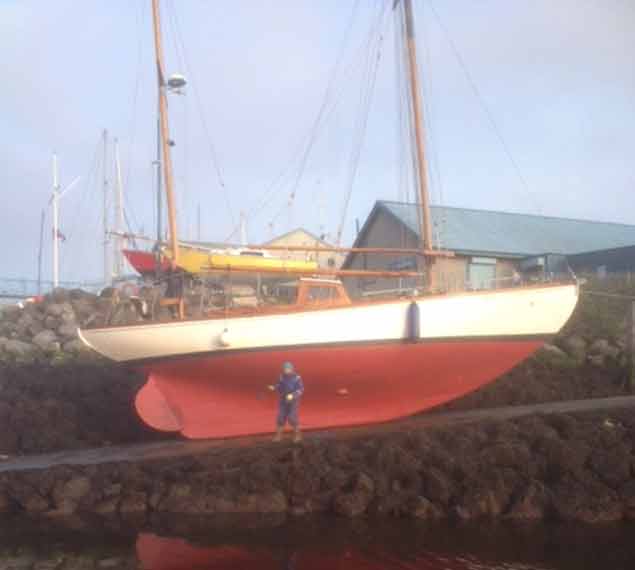 Race preparation. Maybird gets completely re-antifouled and with a fresh boot-top a fortnight ago, all in one tide at Poolbeg
Race preparation. Maybird gets completely re-antifouled and with a fresh boot-top a fortnight ago, all in one tide at Poolbeg
The National Yacht Club looks set to gain Royal Ocean Racing Club recognition for its mini–offshore Dun Laoghaire Dingle race as David O'Brien reports in the Irish Times Sailing Column this morning.
The Dun Laoghaire Dingle application is well timed because RORC Commodore Michael Boyd says the London–based club is keen to encourage RORC racing across the UK, not just Channel races.
The June 14th race – first hosted by the NYC and County Kerry’s Dingle Sailing Club in 1993 – is working closely with Dublin Bay Sailing Club (DBSC) and the Irish Sea Offshore Racing Association (ISORA) to develop the “mini-offshore” into an international race.
Incoming race chairman Adam Winkelmann is adding extra spice by adding a new title sponsor and recruiting a French Mini–Transat fleet.
RORC will assess this Volvo-sponsored edition of the race with a view to adding the race to its points series in 2019.
Read the full story in the Irish Times here and more on this year's D2D race here
RORC Announce Two New GBR IRC Championships
The International Rating Certificate (IRC) global rating rule is used for hundreds of events in 40 countries. In UK waters IRC competition is fierce both for the National Championship, organised by the Royal Ocean Racing Club, and for regional championships which range from Scotland to the Channel Islands.
Two new IRC Championships have been added for 2017: an Inland Championship on Lake Windermere and an Autumn Championship organised by Hamble River SC – both add an extra challenge to an existing winter series. In addition to regional events there are championships for Small Boats and Double Handed crews.
Winners of each Championship will also win a special prize package from IRC sponsors Spinlock.
The 2017 GBR IRC Championships are:
Solent (May-October)
Scottish (May)
Sussex (June)
Channel Islands (June)
National (June)
East Coast (July)
Welsh National (August)
South West (August)
Southern (September)
Small Boat (September)
Double Handed (September)
Autumn (September)
Inland (November-March)
Smaller Boats Not Welcome at IRC Euros 2018?
The significance of the RORC decision to merge the Commodore's Cup with the IRC Europeans in 2018 has extra meaning for Ireland given at least half of the Irish fleet will not be eligible to race due to a ratings band change.
RORC has set a lower rating limit of 1.000 so that means, for example, first and second overall at the 2016 Europeans (Irish boats, Anchor Challenge and Harmony) will not be able to compete in 2018.
It is a vastly different situation to that which existed for the inaugural Euros at Cork Week 2016 and also this year's event in Marseilles. The 2017 event has a minimum limit of .900 allowing them this year.
Details of the 2018 event were published by Afloat.ie yesterday here.
Ireland's fleet has a lot of sub 1.000 boats, but particularly the growing Quarter and Half Ton classes.
Two of the strongest classes at the ICRA championships are class 2 and class 3 and effectively IRC organisers (UNCL and RORC) are not giving them a place at their own European championships.
No doubt this is something that will be addressed tomorrow at the ICRA conference in Limerick where RORC will be in attendance and can give an explanation.
'It appears RORC are trying to resurrect the dying Commodores Cup by attaching it to the IRC Europeans, and in so doing is telling smaller, often less wealthy owners, that they are now not interested in them, a leading Irish IRC racer told Afloat.ie'.
A change to a lower limit that at least includes the Half tonners would be to Ireland's advantage.


























